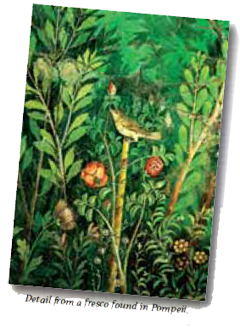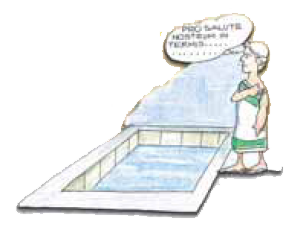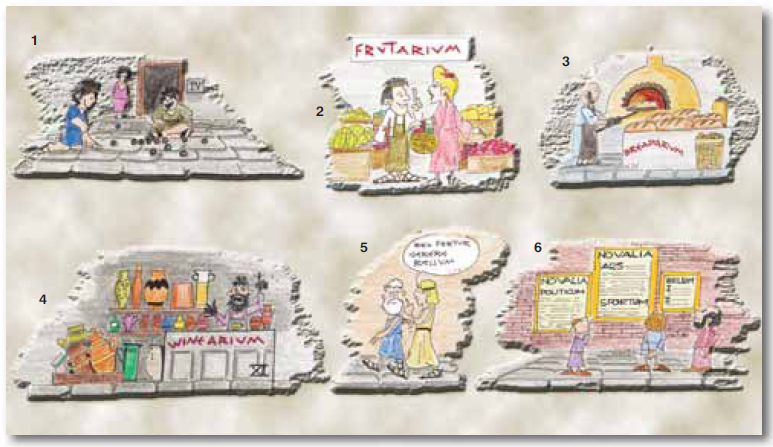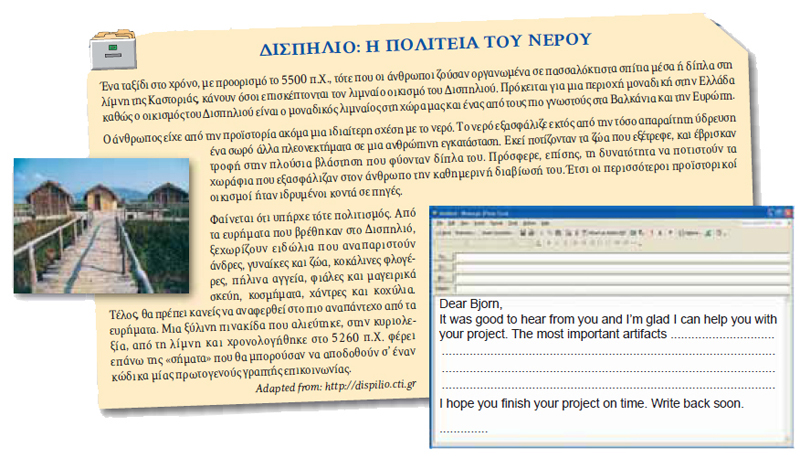LESSON 5 •ACROSS THE AGES
… When Time Stood Still...
I
Almost 2,000 years ago, and only a few days’ journey from Rome by coach, the lively city of Pompeii lay at the foot
of a volcano named Mount Vesuvius. II
Pompeii was a dynamic, commercial centre full of life. There were dozens of shops where shopkeepers sold jewellery
and perfumes, potters worked with clay, and metalworkers and glassblowers amazed passers-by with their skill. There were theatres, bars, taverns and public baths where people used to go to relax and socialise. There was also an amphitheatre where people used to watch gladiators fight. III
Vesuvius had not erupted in more than a thousand years. There had been an earthquake some years earlier, but no
one could imagine what would follow… Then, in August AD 79, the earth started to shake again, and a few hours later, the volcano erupted with a tremendous bang. Tons of rocks, ash and hot lava buried Pompeii. Buildings collapsed, fires broke out everywhere. It was a terrifying scene. People everywhere were screaming, children were crying, and others were praying for the destruction to stop. For the city of Pompeii, time stopped here. IV
In 1748, when archaeologists began excavations, they discovered that the lava had
not only destroyed Pompeii, but it had also preserved it. Everything was found exactly the way it had been almost two thousand years ago. Archaeologists found shops, temples, a theatre, wall paintings. The hot ashes had hardened around people’s bodies preserving the positions they were in at the time of the eruption. The bodies had turned into dust, but by pouring plaster into holes in the hardened ash, archaeologists were able to make out their shapes. In some cases, they could even see the expression on a person’s face. Inside the houses they found a half-eaten loaf of bread, eggs, a kettle on the fire. They even found a sign at the entrance of a house saying ‘Cave Canem’, which means: ‘Beware of the Dog’! Adapted from: “Lost Civilisations: Pompeii, The Vanished City”, Time Life Publications

UNIT 2
|
LESSON 5 •ACROSS THE AGES

Look at the pictures. What do
they illustrate? How do you think modern technology can help us predict and deal with natural disasters today? Discuss.
We use the............................................................................. to talk about:
a. an action which was in progress when another action interrupted it. b. an action in progress at a specific time in the past. c. two or more actions happening at the same time in the past. UNIT 2
|
LESSON 5 •ACROSS THE AGES

 UNIT 2
|
LESSON 5 •ACROSS THE AGES
You have decided to enter an art competition. The title of the competition is: “A Street from the Past Comes to Life”. Use the picture of an actual street in Pompeii and bring it to life. Make drawings or a collage showing what people were doing on this street when Vesuvius erupted. You can write a short paragraph to go with your picture.
Look at the pictures below and talk about
what daily life was like for different civilisations of ancient times. UNIT 2
|
LESSON 5 •ACROSS THE AGES
friend answering his questions. I’m working on a project on some of the very first civilisations on Earth. I’m sending you an article I found on the
Internet about a Greek civilisation in Dispilio, but unfortunately it’s in Greek and I can’t make heads or tails of it. I’m counting on you to help me answer these questions: 1. What were the most important artifacts found in Dispilio? 2. What do they tell us about the people who lived there? 3. What role did water play in the development of their civilisation? Please hurry, I have until Friday! … Thanks a million, Bjorn.  UNIT 2
|